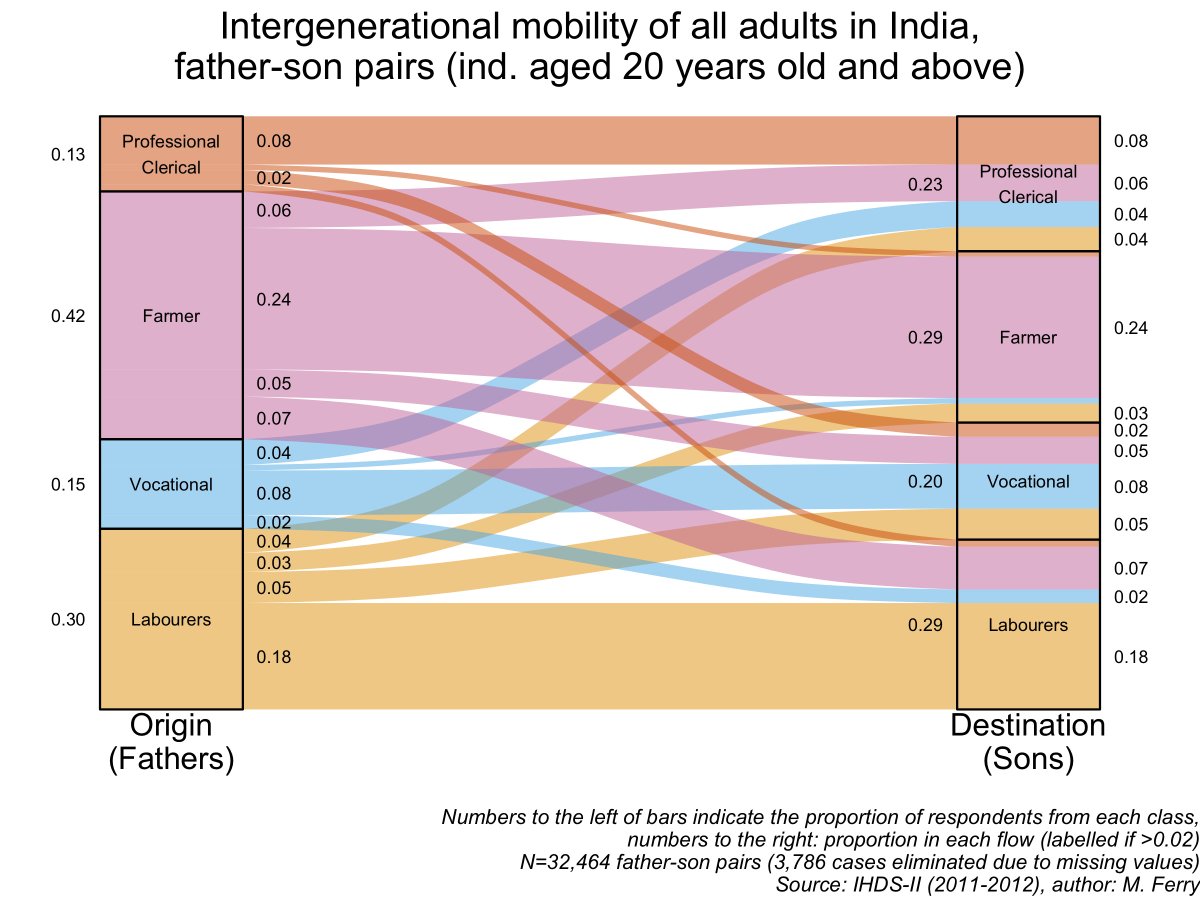How does the ‘tale of two Indias’ look like when examining intergenerational mobility? What’s the fate of Professionals’ sons? Do Laborers’ sons experience upward mobility?
…
The main pattern is social reproduction,
as this graph inspired by @Daniel_Laurison et al. (2020) shows
…
The main pattern is social reproduction,
as this graph inspired by @Daniel_Laurison et al. (2020) shows
This is obvious looking at the flows from one class to another: the thickest one is always remaining in the same class. Hence, in terms of class structure, while Farmers and laborers represented 72% of the fathers’ labor force, they are still almost 60% of sons!
How do the class structure and mobility patterns differ from one social group to another? Here, I focus on Brahmins (Hindu upper castes), Dalit (Hindu low castes) and Muslims, the largest religious minority in India (14% of the population)
…
…
...
…
…
...
A few observations: 1/ Class structure is very different between these 3 groups: 1/2 of Brahmins belong to the prof/clerical class but only 14% of Dalits do. Muslims are in-between with 28%. While 1/2 of Dalits are laborers, less than 10% of Brahmins and 28% of Muslims are
2/ In each stratum, the biggest intergenerational flow is the one of reproduction (flows go from one Origin class into the same Destination class). Look at the prof/clerical class flow among Brahmins and the laborers flow among Dalits!
3/ Structural diffces are so strong that they tend to mask mobility patterns. Thanks to @FlavienGanter’s suggestion, I changes the labels: numbers on the right of each stratum now represent the proportion in each flow relative to the size of Origin or Destination class
Eg 73% of Brahmin fathers in Prof/Clerical positions also have their son in the same cat, respectively 51% of Dalit fathers and 61 of Muslim fathers… And ½ of Brahmin sons in prof/clerical positions had their fathers in the same position, 26% of Dalit sons and 38% of Muslim sons
4/ So upper class reproduction is highest for Brahmins, lowest for Dalits, and Muslims stand again in-between. Inversely, lower class reproduction is the highest for Dalits, lowest for Brahmins and Muslims are in-between.
5/ One can then read that trajectories of extreme downward mobility (prof/clerical workers to laborers) are more common among Dalits and Muslims than among Brahmins. Inversely, trajectories of extreme upward mobility (laborers to higher class) are more common among Brahmins.
6/ What’s the fate of Farmers? When Farmers’ sons do not become farmers (most common pattern!), they tend to become prof/clerical workers among Brahmins while among Dalits and Muslims they rather tend to become laborers: agrarian conversion is more successful for upper castes…
These are just a few observations, which may contribute to understanding the relative position of different caste/religious groups in India. The ambivalent position of Muslims is further studied by @jaffrelotc and Kalaiyarasan (eg see https://indianexpress.com/article/opinion/columns/muslim-community-youth-india-marginalisation-6096881/).
Mobility studies in India have been rare even though sociologists like D. Vaid, @ssjodhka or @JulesNaudet have been extremely important to focus our attention on this topic in the past years. Caste is to a certain extent an occupational class, the caste-class congruence is high…
…But there are also changes in the post-colonial period, particularly thanks to affirmative action, the transformation of the agrarian sector and market liberalization (see eg in http://journals.openedition.org/samaj/4805 ).
Since my own research investigates the cultural consequences of the caste and class (non-)overlap in India, the class mobility visualization presented in the @SociusJournal by @Daniel_Laurison et al is very useful: https://journals.sagepub.com/doi/full/10.1177/2378023120960959.
Here, I used data from the @ihdscorner (2011-2012) and the categorization suggested by V Iversen, A Krishna and @kunalsen5 in ‘Rags to Riches?’ ( @epw_in: https://www.epw.in/journal/2017/44/special-articles/rags-riches-intergenerational-occupational-mobility-india.html) to plot intergen. mobility in India
(and I collapsed professional and clerical categories together, along with Higher and Lower vocational categories to ease the reading. Laborers correspond both to agricultural workers and construction workers, which often switch occupations: “multi-activity”).
Thanks for reading, end of the thread!

 Read on Twitter
Read on Twitter




